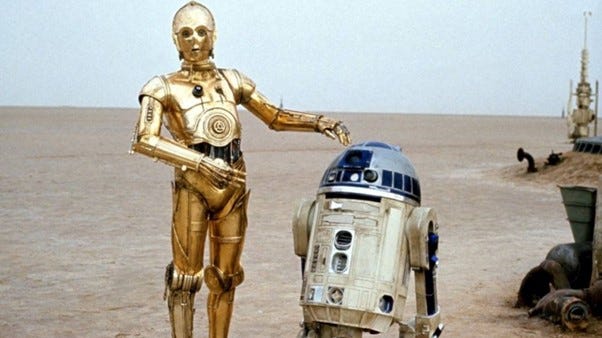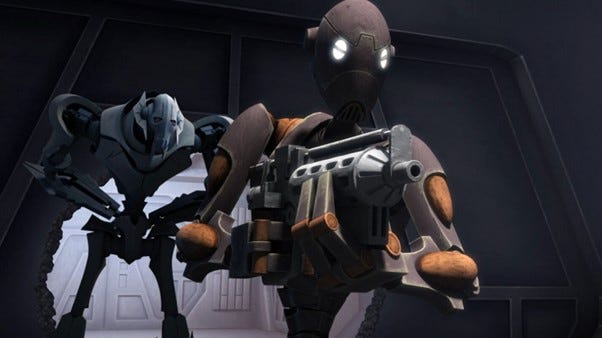AI in Star Wars: Real-World Implications from A Galaxy Far, Far Away
Happy Star Wars Day! May the 4th be with you - a personal essay by the junior editor of AI Business.

May the 4th be with you.
On this day every year, Star Wars fans around the world celebrate the franchise that has redefined storytelling and special effects for almost half a century.
While AI shown in the movies through droids like C-3PO and R2-D2 are a far cry from the autonomous systems we see today, it is easy to imagine what could be.
AI Business breaks down the implications of AI in Star Wars and what it could mean for the real world.

NOTE –this article will contain aspects that are both canonical and non-canon, otherwise known as Legends.
Interfaces: ChatGPT in space
Computers do not work in Star Wars as they do in Star Trek, in that characters will not interact directly with a piece of equipment to generate outcomes.
A notable exception, however, is the case of L3-37, Lando Calrissian’s droid companion who perished during a heist on Kessel.
L3’s brain model was uploaded into the Falcon and acted as the ship's navigational system, helping the gang make the Kessel Run in what would become a record time.
The idea that a computer assisting a human is something that is becoming increasingly popular today, following the rise of ChatGPT. Now, productivity tools are being added to everything from Microsoft Word to Slack.
A spaceship is a far cry from Google Workspace, but the concept of using an AI to help navigate in Star Wars is comparable. AI navigation is not solely applicable at present, with the autonomous Mayflower proving that a human is still required at present to pilot a (water-faring) ship.
But in tandem? AI could prove a valuable addition to everything from boats to planes. AI-powered officers of the watch are already a thing, thanks to the likes of Orca AI, so maybe it's just a matter of time before human drivers have their own L3s.
Anyone can just make AI?
One of the most famous droids in all of Star Wars is C-3PO, the cowardly golden droid that was built by Anakin Skywalker in his home on Tatooine. In Episode I: The Phantom Menace, he says, “He's a protocol droid to help Mom.”
According to lore, C-3PO was built by Anakin out of parts from scrapped Cybot Galactica droids in one of Watto's junk piles. However, C-3PO appears identical to most protocol droids, including the stewardess droid on the Trade Federation’s ship which appears in the same film. That begs the question, can anyone just make these?

C-3PO (left) and his faithful companion, R2D2. Lucasfilm/Disney
While the design may questionable, the technology inside them appears to be protected by some form of intellectual property laws, as Cybot Galactica (CG) one of the two largest droid manufacturing companies in the galaxy, according to the Legends side of the story, installed AA-1 VerboBrains into their protocol droid line. This particular VerboBrain, a sphere-shaped piece of tech found in a droid’s head that functioned as a central processor, was manufactured by SyntheTech Corporation.
While a boring legal conundrum, the concept of AI infringement is one we have yet to address, but one we are just starting to grapple with.
Take AI image generation tools like DALL-E, Stable Diffusion and Midjourney. These systems are trained using images put into them. But who owns those images? Surely crawling the internet and using images to train models counts as infringement? This is a question only just being asked today, as a handful of artists and Getty have only just begun legal action against several text-to-image applications over this issue.
Star Wars may showcase uniform droids here and there, but the idea of similar-looking AI tools is something humanity will soon grapple with in real life. Especially considering the likes of OpenAI keeping their latest models closed to prevent information on them from spilling out, as in the case with GPT-4.
Robotic armies: Poor hardware = limited soldiers
During the Clone Wars, the Confederacy of Independent Systems, or Separatists, used a large droid army.
These battle droids were initially controlled by one central unit, before switching to each individual droid being given their own.
The vast majority of units had limited intelligence and were programmed to follow orders, and not much else. Due to subpar hardware, they had an issue of being ‘chatty’ and would often spout nonsense – similar to how ChatGPT and Bard hallucinate.
Some droids, like the BX-series droid commando (below) or the IG-100 MagnaGuard, were more intelligent, but these were few and far between largely due to manufacturing costs.

The cyborg General Grievous looks on as a BX-series droid commando attacks. Lucasfilm/Disney
The parallels to real-world armies are that many militaries around the world are getting to grips with AI, but nowhere to the capacity seen in Star Wars.
For one, AI is nowhere near advanced as to power an entire army of machines. Instead, AI is being used on the battlefield to improve decision-making for on-field commanders, like in Ukraine.
Here, Star Wars teaches that inferior hardware could lead to disaster on the battlefield. The Clone Wars TV series often showed how the droid army would be fooled by their organic counterparts. Any future army wanting robotic soldiers would likely need to weigh the cost with their needs to be effective on the ground.
One concept that has found its way from Star Wars into reality is the idea of AI-powered fighters.
General Lando Calrissian encountered auto-fighters on the planet Rekkana sometime after the destruction of the second Death Star. These were TIE fighters that operated autonomously. In reality, militaries including the U.S. Air Force, are developing AI-powered fighters.
And of course, the far safer, if only just, autonomous cars from the likes of Cruise and Tesla are slowly emerging. A far cry from TIE fighters, but a real-world idea of what could come in the future.
Malevolent AI?
The droid army of the CIS was not necessarily malevolent, with only the sinister Count Dooku, General Grievous and Darth Sidious the main encouragers of a group that largely just wanted freedom from what they saw as a corrupt Republic.
But there were some instances of AI going bad in Star Wars. For example, both the Sith assassin droid HK-47 and the heavily modified B1-series battle droid Mister Bones shared murderous personalities, treating non-droids that were not their masters with disdain.
And IG-88, the droid bounty hunter seen in the Empire Strikes Back led a strike force to take control of the second Death Star. The droid managed to insert his consciousness into the central computer, gaining access to the most powerful weapon in the galaxy to command a droid army that would start a droid revolution against non-droids.

IG-88 joins Boba Fett on board the Executor as Darth Vader tasks the bounty hunters with finding the Millennium Falcon. Lucasfilm/Disney
The concept of general artificial intelligence - when intelligent machines mimic general human cognitive capabilities to perform any task – is a far cry from the AI of today. So the fear of malevolent AI is a distant one.
But it is not a concept to be treated lightly. The widely reported hallucinations of Tay AI and later Bing AI Chat show there is a natural fear of AI from humans.
AGI is only just a few years away, according to Google DeepMind CEO Demis Hassabis, so the fear of a malevolent AI should have societies preparing for an eventuality, which one hopes never comes.
Read more about:
ChatGPT / Generative AIAbout the Author(s)
You May Also Like


.jpg?width=700&auto=webp&quality=80&disable=upscale)
.jpg?width=700&auto=webp&quality=80&disable=upscale)

.jpg?width=300&auto=webp&quality=80&disable=upscale)
.jpg?width=300&auto=webp&quality=80&disable=upscale)
.jpg?width=300&auto=webp&quality=80&disable=upscale)
.jpg?width=300&auto=webp&quality=80&disable=upscale)
.jpg?width=300&auto=webp&quality=80&disable=upscale)